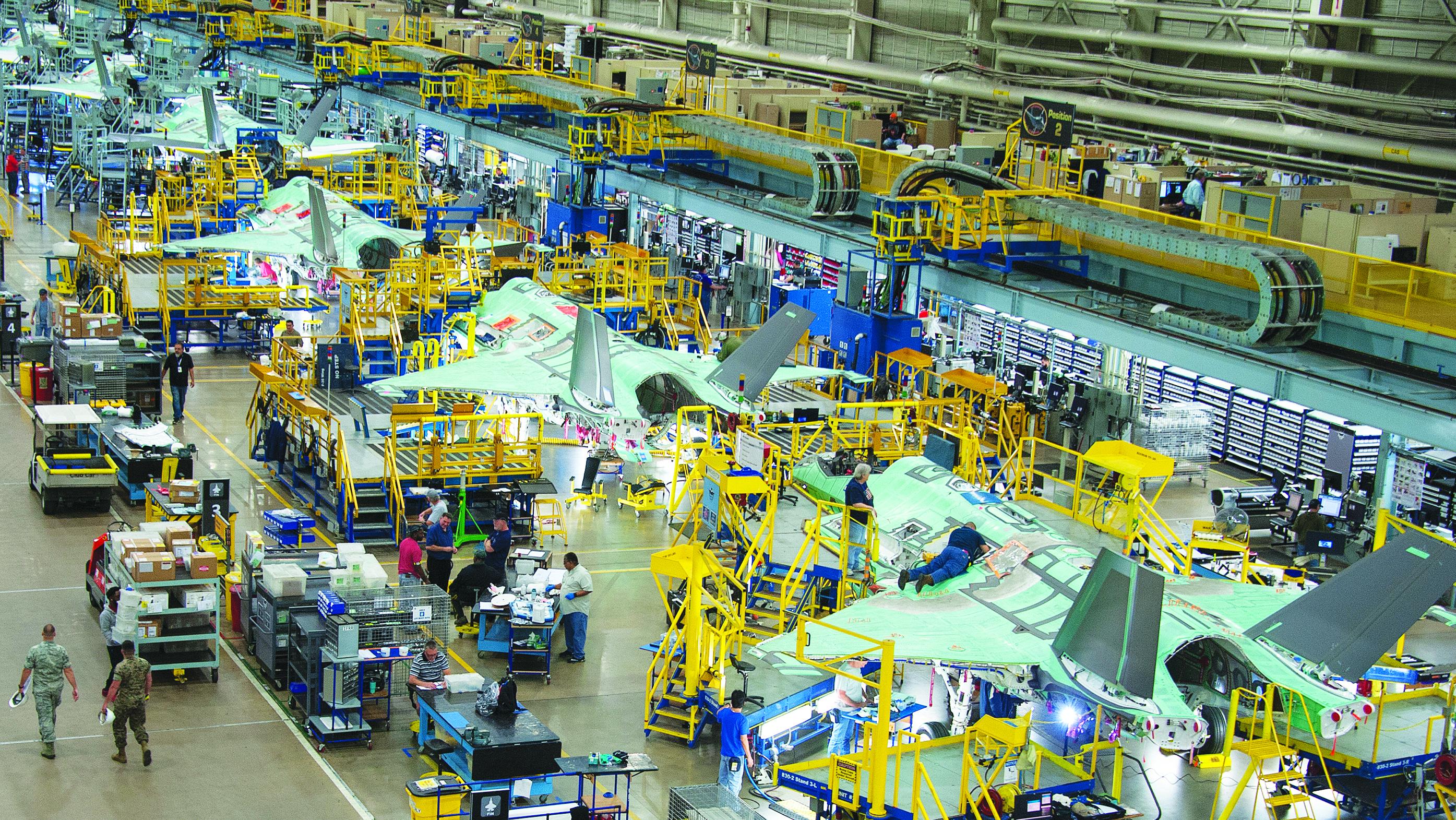新型コロナウィルスの影響でF-35の生産が遅延

今年はロッキードマーチン社がF-35の生産を進めるにあたって、比較的簡単な1年になるはずだった。2017~2019年の3年間で年間納入機数が2倍以上になるという生産数の拡大は、2020年が始まると落ち着いた。同社は2020年に141機のF-35を納入予定で、それは2019年より7機多いだけだった。
しかし、F-35のサプライチェーンもまた、コロナ危機による世界規模の混乱を避けられなかった。同社は4月に第1四半期の業績発表をした際、生産の遅延が予想されることを示唆していたが、5月19日には実際に影響が出ていることを認め、納入予定数は117~124機になるという新たな見通しを示した。もし同社が今年後半にペースを回復できなければ、F-35プログラム史上初めて、納入数が前年を下回ることになる。
「とはいえ、コロナ危機以前の状況に戻り次第、生産ペースを加速させる。そうすれば減少幅も小さくできるだろう」と同社は説明する。
同社の新たな業績予想はF-35の納入数減少を織り込んでおり、純売上高は622.5億ドル~640億ドルに減少する(当初予想は627.5億ドル~642.5億ドル)。他にもF-35の大規模サプライヤーとして、ノースロップグラマン社(中央胴体・レーダー)、レイセオンテクノロジーズ社(エンジン・EODAS:電子光学分散開口システム)、BAEシステムズ社(後部胴体・電子戦システム)等が挙げられる。
現時点では、2020年に当初予定の納入ができなくなる可能性がある18~24機が、どの顧客向けの、どのタイプの機体なのかは不明だ。
米国防総省は、同省においてF-35プログラムは単体では最大の生産システムであることから、状況を注視している。今のところ、調達担当幹部は兵器システム生産に及ぼすコロナ危機の影響は対応可能な範囲に収まるとみている一方、国防総省高官は軍用機産業については例外だと考えている。なぜなら、需要や米軍の予算には影響が出ていないとはいえ、軍用機のサプライチェーンは崩壊しつつある民間機マーケットと密接に関わっており、そこに遅延が生じているからだ。
「サプライヤーの混乱による影響には(軍用)航空機の方が敏感だと考えていた。その原因の多くは、民間機マーケットの激動によるものだ」「多くの航空宇宙関連企業において、軍用機と民間機ビジネスは切り離せないもので、民間機ビジネスがどん底に落ち込んでいる中では、事業を継続し労働力を確保し続けることには少々困難を伴う」と語るのは、米海軍副長官(研究開発・調達担当)のJames Geurts氏だ。
Geurts氏が注視しているもうひとつの領域は、C4I(指揮・通信・統制・コンピューター・情報)だ。同氏は「C4I領域による影響が出ているプログラムの確認を進めている」「しかし直近で影響を確認できているのはやはり航空関連だ」とも語っている。
フォートワースにあるロッキードマーチン社のF-35組立ラインは、4月中旬の新型コロナウィルス感染拡大により大きな影響を受けた。従業員の1人、Claude Daniels氏は、感染症状を上司に伝えた後で亡くなった。感染から回復した別の従業員は、病床にいる際にFacebook ライブ配信を行い、たとえそれが自分の担当業務ではなかったとしても作業場を消毒するよう、組合員でもある同僚達に呼びかけた。
同社経営陣はパンデミックへの対応策として、F-35組立ラインに新たな仕組みを導入した。その中には、定期的な機器類の消毒や、感染者との接触者を隔離することなどが含まれている。
F-35の生産システムに対する圧力はコロナ危機だけではない。ロッキードマーチン社は2019年にF-35全体の納入目標を3機上回ることができたが、まだ生産に習熟していないF-35Cが足かせになり、あやうく目標を達成できなくなるところだった。それを補うために、同社は2020年に納入予定だった4機のF-35Aを2019年末に前倒しした。これにより、目標に対して1機不足だったところを、3機上回ることができた、というわけだ。
コロナ危機以前から、2017~2019年にわたる3年連続の増産は、F-35の世界規模のサプライチェーンに無理を生じさせていた。米国会計検査院(GAO:Government Accountability Office)の報告によれば、部品納入遅延の件数は2017年には2,000件だったものが、2019年には10,000件に達していた。また、毎月の部品不足も2018年は875件だったのに対し、2019年には8,000件に跳ね上がった。この不足は、30万点に及ぶF-35の部品点数から見ればごく一部に過ぎないが、それでも需要を満たすためにサプライチェーンに強い圧力がかかっていたことを垣間見ることができる。
以上は、Steve Trimbleが Aviation Week & Space Technologyいた記事です。 Aviation Week & Space Technology は、豊富な経験と人脈を持った専門家により、最新トレンドや最適な状況判断、ポリシー・要求仕様・予算に関する充実した情報を継続的にお届けします。 Aviation Week & Space Technology をもっと知りたい場合、こちらをクリックして下さい。
This was supposed to be a relatively easy year for Lockheed Martin’s F-35 production. As 2020 began, the stealth fighter program’s three-year growth spurt had subsided after annual deliveries more than doubled between 2017 and 2019. Lockheed planned to deliver 141 F-35s in 2020, only seven more than in 2019.
But the F-35 supply chain is not immune from the global disruption caused by the COVID-19 pandemic. After signaling during a first quarter earnings call in April that a production slowdown was likely, Lockheed confirmed the impact on May 19. The company issued a new forecast of 117-124 F-35 deliveries this year. If Lockheed is unable to recover in the second half, the slowdown would mark the first year-over-year decrease in F-35 deliveries since the program began.'
“However, we will accelerate production when we return to pre-COVID-19 conditions and could see this number decrease,” the company says.
The company’s new financial guidance reflects the lower F-35 delivery total, with net sales for the year falling to a range of $62.25-64 billion from $62.75-64.25 billion. Other large F-35 suppliers include Northrop Grumman (center fuselage, radar), Raytheon Technologies (engine, distributed aper-ture system) and BAE Systems (aft fuselage, electronic warfare suite).
It was not immediately clear which customers and variants would be affected by the potential shortfall of 18-24 F-35 deliveries in 2020.
The Defense Department is closely watching the F-35, its single-largest production system. So far, senior acquisition officials expect the overall impact of the novel coronavirus on weapon system production to be manageable. But the Pentagon leadership considers the military aircraft industry an exception. Although demand and domestic U.S. military spending remain intact, the military aviation supply chain’s links to the collapsing commercial aircraft market is causing delays.
“I think [military] aviation has had a more acute sensitivity to supplier disruptions, largely driven by the massive upheaval in the commercial aviation market,” said James Geurts, assistant secretary of the Navy for research, development and acquisition. “Many of the aerospace companies were blended between military and commercial, and with commercial just falling through the floor, their abilities to stay open and keep their workforce has been a little bit more challenged.”
Another sector Geurts is watching is the market for command, control, communications and computers and intelligence (C4I). “We’re trying to track all of it,” he says. “But the most immediate impact we’ve seen has been on aviation.”
Lockheed’s F-35 assembly line in Fort Worth was hit hard by the COVID outbreak in mid-April. One employee, Claude Daniels, died after reporting COVID-19-related symptoms to a supervisor. Another F-35 employee, who survived, broadcast a Facebook Live video from his hospital bed, pleading with his unionized co-workers to sanitize their workspaces even if it is not in their job description.
The company’s management has said that the F-35 assembly line adopted new protocols in response to the COVID-19 pandemic, which included regularly sanitizing equipment and quarantining employees exposed by co-workers or others to the virus.
The COVID-19 response is not the only pressure on the F-35’s production system. Lockheed exceeded the overall delivery target by three aircraft in 2019, but slower production of the less mature F-35C airframe nearly caused the company to miss the annual goal. To compensate, Lockheed moved up deliveries of four F-35As originally scheduled for 2020 to the end of 2019, allowing the company to beat the delivery target by three aircraft instead of missing it by one.
Before the impact of the virus, the F-35’s global supply chain was already strained by the three-year production ramp-up from 2017 to 2019. Late part deliveries jumped to 10,000 in 2019 from 2,000 in 2017, according to a May report by the Government Accountability Office (GAO). Monthly parts shortages, meanwhile, leaped to 8,000 in July 2019 from 875 a year before, the GAO says. The shortages represent a fraction of the 300,000 parts in each F-35, but the trend offered a glimpse of the pressure on the supply chain to meet demand during the ramp-up.